#function notation
Explore tagged Tumblr posts
Text



#precalc#pc1u1#algebra 2 review#ordered pair#function notation#parent function#vertical line test#horizontal line test#one to one
1 note
·
View note
Text
Meme that my math teacher put on our lessons:

#random#math#math humor i guess??#memes#math jokes#if this wasnt on the lesson i would have been so confused about function notation#it definitely made things clearer LOL
1K notes
·
View notes
Text
okay, there is no way that gotham city DOESN'T think brucie wayne and batman are dating. no fucking way.
how else could this man survive? you know randoms would be accosting him at his local froyo place otherwise, because this is brucie wayne we're talking about.
brucie "has a billion dollars but zero street smarts" wayne.
brucie "carries around one grand as 'pocket change'" wayne.
brucie "oh, you want those three little digits on the back of my card? sure! which one?" wayne.
brucie "money doesn't grow on trees?" wayne.
#dc#dcu#bruce wayne#brucie wayne#batman#dc batman#gotham#idk how i came up with this while doing function notation but wtv#you work in mysterious ways muse
113 notes
·
View notes
Text
I need to personally kill Newton and Leibniz and every professor who insists on teaching the archaic and severely outdated and redundant ideas and concepts of limits, interpreting derivatives, and curve sketching. Anyone who says Calc II is harder than Calc I is horribly wrong and should have tomatoes thrown at them
#Guess who just had the worst test of their life#I miss my wives derivatives and integral functions#I miss my husbands sigma notation and riemann sums#sp-rambles#I even miss my weird queerplatonic joyfriend trigonometric identities and logarithmic functions at this point
10 notes
·
View notes
Text
Suppose you have 2 paths p : x ↝ y and q : y ↝ z. What's a better symbol for their concatenation, the path (p ? q) : x ↝ z?
(That is to say, we have 2 continuous functions p,q : [0;1] → X, with endpoints p 0 = x, p 1 = q 0 = y, q 1 = z. )
#math#posts#polls#yes yes it's normally written p(0)#but you'll pry lambda-calculus' function application notation from my cold dead arms
12 notes
·
View notes
Text
it does feel good to build a skill from the ground up and i know that i’m going to be grateful for this vectorworks experience later but right now all i want to do is eat drywall
#CHRIS WHAT ARE POSITION NOTATIONS. THIS ISNT A FUNCTION OF VECTORWORKS#i just labeled the lights with a box and title that says they’re at shin height on the deck. hopefully that’s fine#i need to post about something other than vectorworks. it’s taking over my life#(circus music starts)
2 notes
·
View notes
Text
If you ever wonder what dyslexia is like I suggest going to a uni math couse because I straight up know all these symbols and it took me like 15 minutes to figure out what fucjing X = {f ⊆ ℕ × ℕ: ∃A ⊆ ℕ f ∈ ℕᴬ} means
#original broth#mathblr#math#mathematics#set theory#X is the set of all functions from subsets of the naturals to the naturals. thats so much easier to understand AND to write into a computer#why do they DO formal notation to us
2 notes
·
View notes
Text
<— Unit 13: Part 3—>
Piecewise Functions
#1
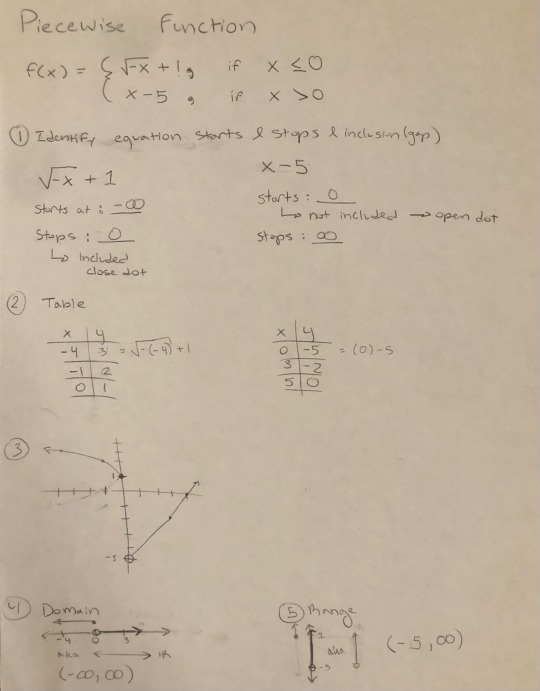
#2

#3

Page 40
2 notes
·
View notes
Text
BLOCKHEAD GRANDE IN 3 TRIES LETS GO
#tip if you're playing on switch#utilize the 30 sec record function and start recording right after the last spit appears#dont pull out your brush yet#immediately switch to home screen and open up the video#have a spare paper at hand and draw a scaled down model with prominant cracks of blockade#draw the dots with notations on the order#then go back to the game and open up your brush#cheers#okami#using main tag so other people dont have to suffer as much as i did
1 note
·
View note
Text
Interval Notation

Example Single vs Dual
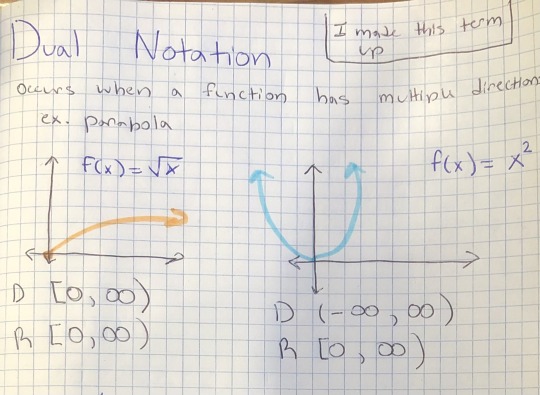

By multiple direcrions I mean more than 2.
ie. 1/x has 4 different directions
0 notes
Text
CALLING ALL DOLLS, DRONES, ROBOTS AND CODING ENTHUSIASTS
Are you a robot that loves to serve? Are you a doll maid who seeks guidance in your duties? Are you some form of drone or being with no free will, open to having your actions dictated by the will of your owner? Does the idea of your empty mind being programmed like a machine appeal to you?
Are you enticed by the notion of writing code for your robotic servants? Are you a witch looking to create more intricate control glyphs? Are you an owner seeking to create automated instructions for your drones? Do you love the idea of filling an empty mind with rules and instructions to reflect your will?
INTRODUCING DRONE RESTRAINT NOTATION!
WHAT IS IT?
Drone Restraint Notation, or DRN, is a pseudo programming language created by my good friend Errant Spark, a drone with a very creative <empty space>. I helped with some of the final tweaks for the 1.0 version, but this is almost entirely Its creation.
It is a programming language that is designed in such a way that anyone without a background in programming can execute the commands like a machine, doll, drone, or programmable entity of your choice. It is also simple enough that most people without a background in programming can pick it up fairly easily, and intuitively!
Once you understand the language, you can read and execute all kinds of dynamic instructions and instruction types, in a way that makes it easy to parse in a plain-text format.
HOW DOES IT WORK?
The main documentation document will provide far more detail to this question than I ever could, but effectively it goes like this:
There are a list of eight KEYWORDS, in block capitals, that show you the type of instruction you’re executing. Then, after the KEYWORD, the instruction’s details are shown. Commands are read and executed from top to bottom by the drone, and programs can be ‘inserted’ into the drone’s memory at will (Assuming prior consent, of course)!
These KEYWORDS all have different kinds of functionality. The most basic one just has you carrying out a task. One checks if a condition is true, one provides an ongoing task you have to prioritize and maintain, one lets you create loops, etc.
The language has been designed in such a way as to minimize the amount of actual memorisation a drone has to do, and only has to read what’s right in front of them, and memorize tasks they have to accomplish/maintain. Obviously, mileage may vary depending on the memory space of the doll.
WHY SHOULD I USE IT?
For fun, I suppose! If you are someone who loves the idea of being programmed like a machine, executing only the instructions given, then this provides that! If you are a programmer who wants to program your very own doll bot, then this is a great place to get started too!
You can keep things nice and simple with a headspace that accepts basic command inputs, or you can see how deep the rabbit hole goes and import whole libraries into your headspace to carry out a full day’s maid duties, or sexual duties, or more!
Have fun executing commands, writing new code, testing it on your dolls. Have some playful fun watching as your early code files cause unintended behaviors, ironing out kinks and bugs like a real programmer until you’ve got your bots performing all sorts of dynamic tasks- or insert purposeful bugs to make your robots twitch and halt~
As with all things, never execute an instruction that you cannot/would not consent to. This is meant to be fun, and is NOT meant to be a way to circumvent normal consensual kink play. Programmers who attempt to use DRN as a way to bully people into doing what they want (Unless you’re into that sort of thing, in which case go nuts) do NOT have my endorsement, or the endorsement of Errant Spark.
NOW GO OUT THERE, AND ENJOY YOUR PROGRAMMING <3
>> Posted by XCN-PSD/I-04135
#dollcore#empty spaces#dronification#doll posting#rubber drone#robotkin#robot kin#ai kin#aikin#mind control#mind conditioning#brainwashing#robotfucking#robotfucker#robot fucker
1K notes
·
View notes
Text
Vincent may be aware of the multiverse (UPDATE. MORE DATA DISCOVERED)
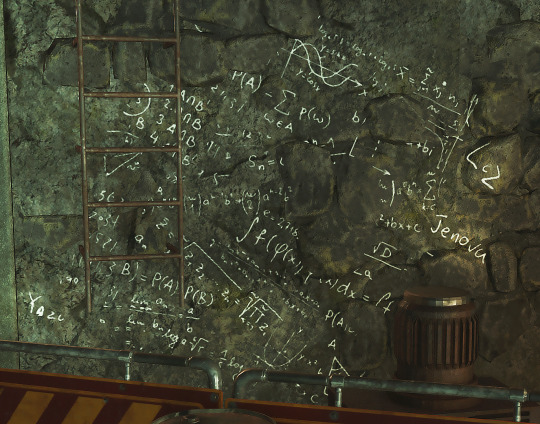
Firstly-- credit to @XTurkValentine (Twitter) who graciously shared this information with us. They connected with mathematicians and asked them to deduce what was written in Vincent's basement, and what they discovered seems to imply something fascinating about Vincent...
According to the math professors who studied this image, Vincent used a mixture of several mathematical equations, including the following:
Calculus with integrations, differential equations, summation notations, probability, statistics, complex analysis, physics, etc.
What's more interesting is that there's evidence of quantum mechanics. For example:
∫f(ϕ(x))dx: represents integrating a function over a space
P(A)=P(B)P(A∣B): describes conditional probabilities of events
In other words-- this all suggests that Vincent is aware of the multiverse as well as how different events are affected by them. His awareness of how the planet functions may even be similarly in tune with what Sephiroth knows. This further implies that there is a small chance Vincent is also aware of Chaos and his ultimate fate when it comes to the planet's function. Granted, he may not have the whole picture as much of that should still be hidden in Lucrecia's missing files. Nevertheless, if all of this tracks, this implies that Vincent may not be quite as oblivious as he was in Dirge of Cerberus.
656 notes
·
View notes
Text
I've noticed recently a rapid increase in usage of the verb "to gift", where ordinarily people would simply say "to give" (with "as a gift" obviously implied, since all gifts are given).
I think the nuance in meaning is that when you are gifted something, you are given something by the giver's own charity or goodwill. You could say that it prevents the possible reading of being given something in exchange for something else, or being given something at your own request.
Anyway, it parallels a sort of thing you see in Latin:
You have a verb, usually 3rd conjugation, like canere, to sing. This has the passive participle cantus, sung. Then cantus becomes a noun, cantum, as in a song (and song in English is originally a variant of sung/sang). Then the noun becomes used as a verb, cantare, "to song", or more like "to sing a song". Then cantare and canere survive alongside each other (though in Biblical Latin, cantare is used way more).
Likewise,
dicere: to speak -> dictus: spoken -> dictum: a saying -> dictare: to give a saying, to dictate
noscere: to know -> notus: known -> notum: that which is known -> nota: a mark of that which is known (a note) -> notare: to make a note, to note, to notate
There is an obscure example in English: to will. Will originally meant "to desire", but has largely been replaced by "want", and now functions as an auxiliary verb to indicate the future tense. But the older meaning survives in the noun form: "Thy will be done", a legal will, "men of good will", etc. The verb "to will" (note there is no to-infinitive for the future will) has the past tense "willed" and not "would", and seems to come from will as a noun and not as a split from the original verb. Note: god will vs god wills.
In Old English: willan: to desire (becomes future will) -> willa: a desire -> willnian: to have a desire (becomes to will) (-nian is a suffix attached to nouns to form verbs).
Anyway, all that said, I'm not a fan of to gift as a verb.
131 notes
·
View notes
Text

Hope
'You have a rare and marvellous spirit...'
A few weeks ago, I did an illustration of Solas's spirit form and got to wondering what my Lavellan might look like as a spirit, and what their nature might be. There are a number of allusions in Dragon Age: Inquisition that the Inquisitor's spirit is unusual, and since all the lore drops in DATV I've been wanting to explore what that might mean. We don't know if it's unusual or if it's just down to the Anchor--Cole says it makes them 'more', but there are other things mentioned here and there that there's something weird about them anyway. Hope seems like a good bet for their nature given all the events in the story, so this is what I based the design on.
I chose 8 'wings' as a reference to one of my favourite films, Angel's Egg, where the coelacanth is used as an allegory for faith. Coelacanths are one of the oldest fish species on Earth and were thought to be extinct until the 1920s, when a live one was caught off the coast of South Africa. Before this, there were only fossil records. Coelacanths have 8 fins, with their tailfin having 3 lobes. It felt like a fitting reference to make given that both Angel's Egg and DAI are stories about faith and hope.
The spindly bits are based on siphonophores, which are deep sea creatures that, instead of growing larger, create duplicates of themselves with single functions. E.g., some parts only have mouths, for eating. Long strings of them live in the open ocean, and to me they look like musical notation--this also fits with the line 'everything sang the same' and how Solas and Lavellan's speech is in the same cadence. It's also how I imagine the relationships between spirits to function; they're all parts of a larger body, with differing functions to sustain the whole.
The 'head' is designed to look a bit like a starburst with parhelia or sundogs. (They're called sundogs because it was thought that they were the dogs Zeus walked across the sky by the ancient Greeks.) They're considered a good luck omen i.e. a hopeful sign. The colour palette is based on a sunrise bc 'The dawn will come' is the hymn sung by Andrastians in DAI.
The above quote is said by Solas in the infamous Crestwood scene.
93 notes
·
View notes
Text

Heyo! I wanted to post our build book somewhere so here we gooo

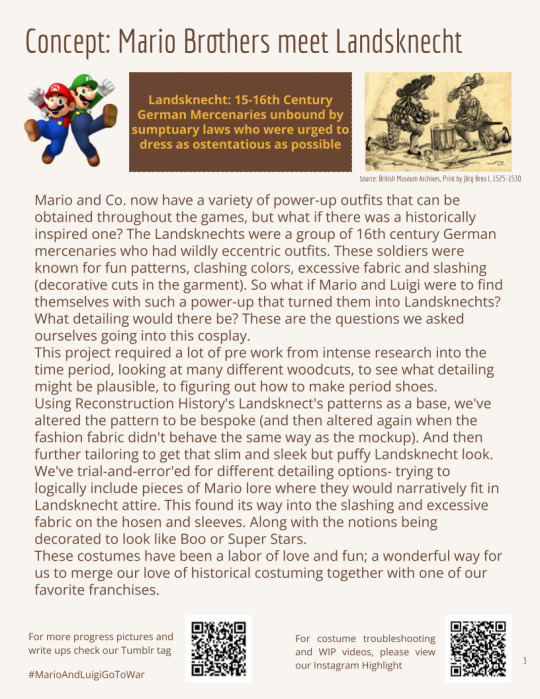
We stole the table of context ontop of finished photo idea from @sarahspaceman who I'm sure saw it from somewhere else. Our cosplays are a little out there so I wanted to give a debrief on just how we came up with this concept along with a way for the judges to find more materials.
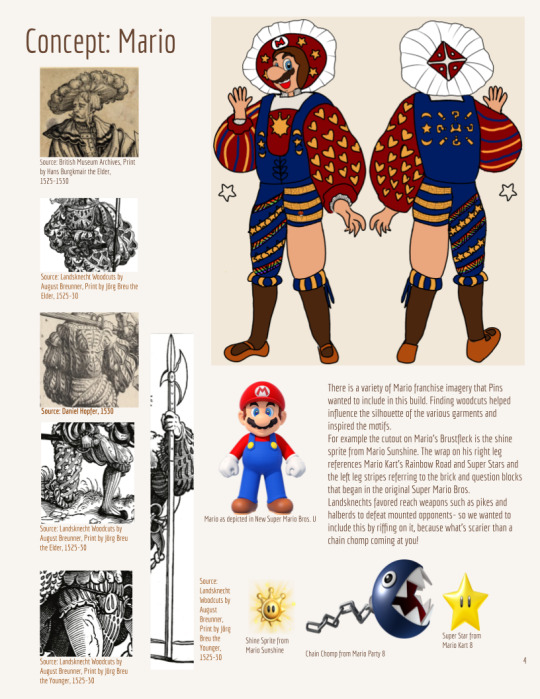
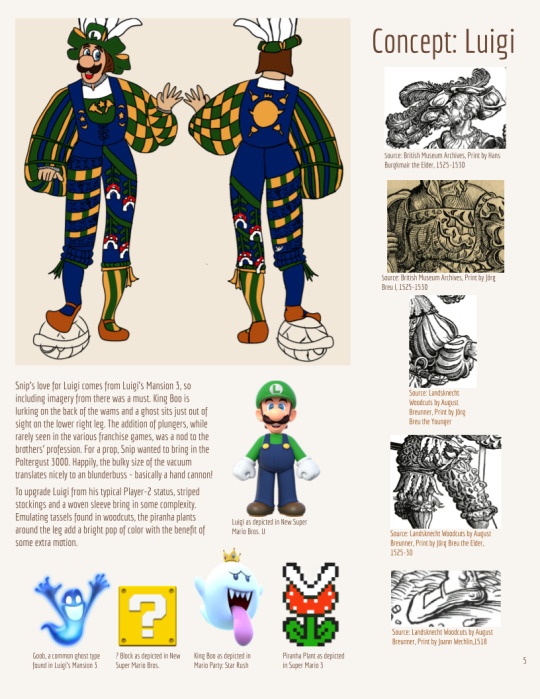
Since this wasn't a thing that existed in any sort of media it was very important to me that the judges would know that we picked from historical imagery, so I wanted to have pictures as examples of what things were supposed to look like. In addition to giving examples from the games of imagery that we used in case they were unfamiliar.


You'll begin to notice a trend of pictures that have their background removed, I just wanted to be able to fit more stuff on the page without compromising space. I also tried to block like sections together to draw the eye easier when reading about certain pieces.
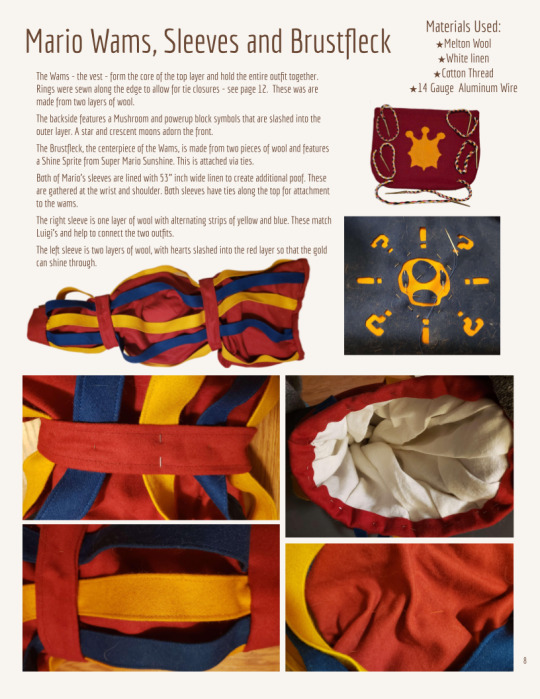

Another thing that I tried to do was keep in mind what the book would look like in physical form, so we tried to mirror where we could.


Fun fact, because I had this pattern notated I was able to go back and use it to make more trim when I decided my butt was too bare. Luigi's Hosen page too a log of finagling to get it too look right with the amount of text I wanted to be on there.


Because we ended up condensing some stuff together, we ended up with an extra page, page 12 became a "here's everything we haven't talked about yet that we want to talk about" By the time we sent off the book for Metro, we hadn't updated the shoes page with their new stained leather- they look much nicer now.


Snip went into a work frenzy and didn't take any photos of him covering the base in worble, but you can take my word for it that it did happen! (I was busy weaving when he was knocking Chain2.0 out) I love love love how the Poltergust turned out. It's a functional backpack and is super sturdy!

Hope you enjoyed our build book! It took us probably about 12 hours to put it together originally and then another 5 to redo the parts of it that didn't make sense in our late night frenzy the first time.
278 notes
·
View notes
Note
Hi there, I’m not a mathematician, so idk if my question is silly, but why is it that integers in set theory are defined as a composition of all the previous integers instead of something simpler like for example just the set containing the previous integer? Is there something that makes the way we official define integers useful, or was it something like “this works, good enough��?
Hey, thanks for your question. What you're describing is actually Zermelo's construction of the integers, which uses the successor function S(n)={n}. You may recognize the name "Zermelo" from his greatest hit "Zermelo-Frankel set theory", the all-time most popular theory of sets, and arguably the de facto foundation of all modern mathematics. So, you are in good company in thinking that's the obvious implementation. However, the Von Neumann implementation (used in Hazel's "count to 100" challenge) is considered to be superior, which I think is for three main reasons.
The first and probably weakest reason is its convenience in defining the "<" relation. Under the Zermelo convention, you need to define "<" using the Recursion theorem, but it's much easier to prove Recursion when you already have "<" at your disposal. Having to prove the Recursion theorem without ever mentioning "<" is a pain in the ass. It's not terribly difficult to prove Recursion if you have access to the axiom of infinity, but it's way harder from a finitistic set theory, and that difficulty is compounded if you can't mention the "<" relation (I've done it and it's fucking annoying). I'm not a dirty finitist*, but I do have a deep interest in reverse mathematics, so these kinds of pragmatic concerns are important to me. Under the Von Neumann implementation, we simply have n<k if and only if n∈k, and the successor operation S(n)=n∪{n} isn't much more complicated. (*finitism is an unpopular but nonetheless respected mathematical philosophy, me calling it "dirty" is a joke.)
The second reason is its relationship to cardinality: as a set, a finite ordinal n contains exactly n elements, provided we use Von Neumann's implementation. For example, 0={} has 0 members, similarly 2={0,1} has 2 members, and so on. Besides being elegant for obvious subjective reasons, it's also pretty convenient in certain technical aspects. For example, there's an important set theoretic operation called set exponentiation, where Y^X denotes the set of all functions f mapping X→Y. In the finite case, it holds that |Y^X|=|Y|^|X|, hence the name and notation. This overlaps with the ordinary notation for the set of ordered pairs, X^2 = {(a,b) : a,b∈X}. This is compatible with the set exponentiation operation, but only if we use the convention 2={0,1}. That is, the ordered pair can be thought of as a function with domain {0,1}, in the sense that (a,b)[0]=a and similarly (a,b)[1]=b. This doesn't work under Zermelo's convention. A similar issue arises for triplets at 3, quadruplets at 4, and so on, essentially forcing the Von Neumann implementation all the way up, if we want this elegance. There are other technical roadblocks I'm sweeping under the rug (roadblock shaped like "a function is a set of ordered pairs"), but this answer is long enough already.
The third reason I'll say, and certainly the strongest, is its relationship to infinite ordinal numbers. Infinite ordinals are unbelievably important in set theory, for like a trillion reasons I could talk about for an entire decade, so it's pretty important to have some kind of implementation. The least infinite ordinal is named ω, which is the least nonzero ordinal obeying the property ∀(n<ω), n+1<ω. In other words, ω has no immediate predecessor. Under the Von Neumann implementation, we can simply say ω={n : n is a finite ordinal}, albeit the formal way to say "n is a finite ordinal" is a mouthful of logic. This extends to larger ordinals, in the sense that Von Neumann's convention allows us to easily construct ordinals of any infinite size. There's no good way to extend Zermelo's implementation to the infinite ordinals, so it's just not as good.
TL;DR Zermelo's convention works, but it's very slightly more inconvenient in almost every conceivable way. Nobody actually writes out Von Neumann ordinals by hand (except as a fun joke), so there are no downsides.... unless you don't have Axiom of Replacement, since then you have to use a completely different third convention which almost nobody knows about.
-Lilith
74 notes
·
View notes